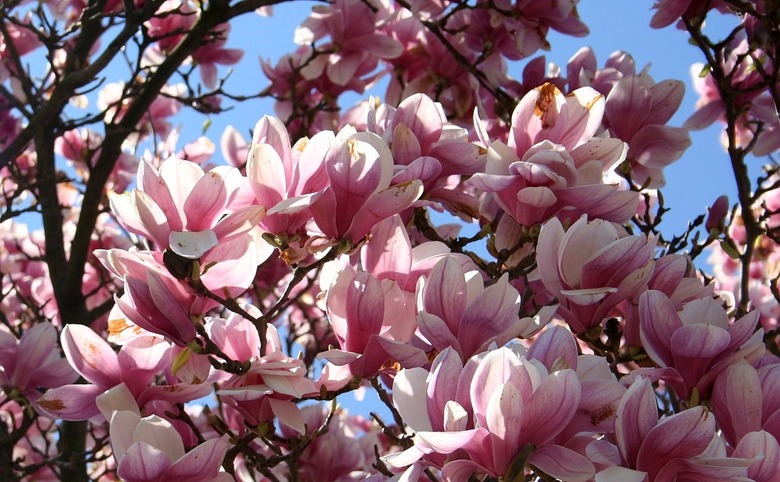How To Start A Magnolia Tree
Things Needed
- Young healthy magnolia tree
- 2 1/2-inch seedling pot
- Peat moss
- Perlite
- Rooting hormone
- Clear plastic bags
- 1-gallon pots
Magnolias include about 80 different species of lush blooming shrubs and majestic flowering trees. These ancient plants have been used historically in folk medicine for thousands of years, then later harvested for their timber. Today they're probably best known and loved for their decorative value, typically boasting large, showy blooms which make them a favorite for landscaping. Although magnolia trees can be successfully started from seeds, propagation from cuttings is easier, requires much less time, and delivers more reliable results.
Step 1
Fill 2 1/2-inch seedling pots with a mix of equal parts moistened peat moss and Perlite, and make a slim hole in the center of each, about 2 inches deep. Have the pots ready to receive cuttings immediately after harvest.
Step 2
Carefully select healthy young magnolia trees to take your cuttings from in early spring or late winter. The mother plants should be trees which you find attractive. Trim 6- to 8-inch cuttings from new shoots, or softwood, making clean diagonal cuts. The bark of the cuttings should be soft and easily punctured by a thumbnail. The cuttings will need to have at least a couple of fully developed leaves at their tips for making food for the magnolia tree. Keep them cool and moist, and plant them right away.
- Magnolias include about 80 different species of lush blooming shrubs and majestic flowering trees.
- The cuttings will need to have at least a couple of fully developed leaves at their tips for making food for the magnolia tree.
Step 3
Prune the stems of the cuttings down to about 4 to 5 inches long, and strip all leaves from the lower 2 inches. Dampen them with water and dip into rooting hormone. Plant the cuttings in the prepared pots, and firm them with the planting medium. Moisten well, but not enough to give them wet feet.
Step 4
Seal the pots of cuttings in individual clear plastic bags. This will ensure that they retain plenty of necessary moisture. Place them in a warm, brightly lit spot, but keep them out of direct sunlight. Good locations are above a hot water heater or on top of the refrigerator.
- Prune the stems of the cuttings down to about 4 to 5 inches long, and strip all leaves from the lower 2 inches.
Step 5
Moisten the planting medium every 2 to 3 days as necessary to keep the cuttings from drying out. You'll see drops of condensation appear inside the plastic, which are supplying humidity to the developing plant, though this may also mean that the soil is drying out.
Step 6
Monitor root development once each week by removing the magnolia cutting and soil ball from its pot. The length of time it takes for magnolia cuttings to begin to root depends upon temperature, humidity, and the plant's variety, so just be patient. When you can see the roots, you can begin feeding the plant. Give it a weekly half-strength application of water soluble 20-20-20 fertilizer.
Step 7
Move the well-rooted cuttings up to 1-gallon pots if it's going to be several more months before you can transplant them to permanent locations outdoors. Since magnolias are notoriously averse to being disturbed or transplanted, plan on moving your young trees in the spring or winter when they are semi-dormant. The magnolias can now be placed in the sunniest and warmest spot you can provide them. Continue to water to keep them uniformly moist, but not soggy.
- Moisten the planting medium every 2 to 3 days as necessary to keep the cuttings from drying out.
- The length of time it takes for magnolia cuttings to begin to root depends upon temperature, humidity, and the plant's variety, so just be patient.
Step 8
Choose a sunny, well-drained location with rich soil for your young tree's new forever home. If that isn't possible, the tree will grow satisfactorily in partial shade. Although they're drought tolerant, they really do enjoy moist soil conditions. Plant the tree where it will be protected from high winds, which can do a lot of damage to brittle magnolia limbs and their large, beautiful flowers.
